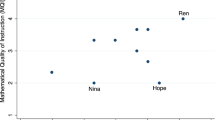Abstract
This study explores the ways in which eleven preservice elementary teachers used a web-based teacher resource to apply a mathematical definition, to correct a procedural error in arithmetic, and to make sense of a story requiring the multiplication of fractions. In our analysis we propose a framework to compare the behaviors and values expressed by our participants with the values and norms of the mathematical community. This analysis suggests that many preservice elementary teachers are profoundly mathematically unsophisticated. In other words, they displayed a set of values and avenues for doing mathematics so different from that of the mathematical community, and so impoverished, that they found it difficult to create fundamental mathematical understandings.

Similar content being viewed by others
References
Ball, D. L. (1990). Prospective elementary and secondary teachers’ understanding of division. Journal for Research in Mathematics Education, 21(2), 132–144.
Ball, D. L. (1993). With an eye on the mathematical horizon: Dilemmas of teaching elementary school mathematics. The Elementary School Journal, 93(4), 373–297.
Ball, D. L. (2000). Bridging practices: Intertwining content and pedagogy in teaching and learning to teach. Journal of Teacher Education, 51(3), 241–247.
Ball, D. L., & Bass, H. (2003). Making mathematics reasonable in school. In G. Martin (Ed.), Research compendium for the principles and standards for school mathematics (pp. 27–44). Reston, VA: National Council of Teachers of Mathematics.
Ball, D. L., Ferrini-Mundy, J., Kilpatrick, J., Milgram, R. J., Schmid, W., & Schaar, R. (2005). Reaching for common ground in K-12 mathematics education. Unpublished manuscript.
Bauersfeld, H. (1993). Teachers pre and in-service education for mathematics teaching. Seminaire sur la Representation, 78. Canada: CIRADE, Université du Quebec à Montreal.
Carpenter, T., Linquist, M., Mattews, W., & Silver, E. (1983). Results of the third NEAP mathematics assessment: Secondary school. Mathematics Teacher, 76(9), 652–659.
Chazen, D., & Ball, D. L. (1999). Beyond being told not to tell. For the Learning of Mathematics 19(2), 2–10.
Conference Board of the Mathematical Sciences. (2001). The mathematical education of teachers: Part I. Washington, D.C.: Mathematical Association of America.
Eddington, A. S. (1928). The nature of the physical world. Cambridge: University Press.
Fennema, E., & Franke, M. L. (1992). Teachers’ knowledge and its impact. In D. Grouws (Ed.), Handbook for research on mathematics teaching and learning (pp. 147–164). New York: Macmillan Publishing Company.
Gallian, J. A. (1998). Contemporary abstract algebra (4th ed.). New York: Houghton Mifflin Company.
Goos, M. (2004). Learning mathematics in a classroom community of inquiry. Journal for Research in Mathematics Education, 35(4), 258–291.
Halmos, P. R. (1985). I want to be a mathematician. Washington: Mathematical Association of America Spectrum.
Hardy, G. H. (1941). A mathematician’s apology. London: Cambridge Press.
Hill, C. H., Schilling, S. T., & Ball, D. L. (2004). Developing measures of teachers’ mathematics knowledge for teaching. Elementary School Journal, 105(1), 11–31.
Hill, C. H., Rowan, B., & Ball, D. L. (2005). Effects of teachers’ mathematical knowledge for teaching on student achievement. American Educational Research Journal, 42(2), 371–406.
Lampert, M. (2000). Teaching problems and the problems of teaching. New Haven, CT: Yale University Press.
Ma, L. (1999). Knowing and teaching elementary mathematics. Mahwah, NJ: Lawrence Erlbaum Associates, Inc.
National Council of Teachers of Mathematics (2000). Principles and standards for school mathematics. Reston, VA: Author.
Newman, J. R. (Ed.) (1956). The world of mathematics. Vol. 3. New York: Simon and Schuster.
O’Connor, J. J., & Robertson, E. F. (2003). Jules Henri Poincaré. Retrieved December 13, 2005 from http://www-history.mcs.st-andrews.ac.uk/Quotations/Poincare.html.
O’Connor, J. J., & Robertson, E. F. (2004). Pierre Simon Laplace. Retrieved December 13, 2005 from http://www-history.mcs.st-andrews.ac.uk/Quotations/Laplace.html.
Poincaré, H. (1946). Foundations of science: Science and hypothesis, the value of science, science and method. (G. B. Halsted, Trans.). Lancaster, PA: Science Press.
Polya, G. (1957). How to solve it; a new aspect of mathematical method. Garden City, NY: Doubleday.
Russell, B. (1931,1954). The scientific outlook. New York: W. W. Norton & Company Inc.
Schuck, S. (1996). Chains in primary teacher mathematics education courses: An analysis of powerful constraints. Mathematics Education Research Journal, 8(2), 119–136.
Seaman, C., Szydlik, J., Szydlik, S., & Beam, J. (2005). A comparison of preservice elementary teachers’ beliefs about mathematics and teaching mathematics: 1968 and 1998. School Science and Mathematics, 105(4), 197–210.
Shulman, L. (1986). Those who understand: Knowledge growth in teaching. Educational Researcher, 15, 4–14.
Simmons, G. (1992). Calculus gems. New York: McGraw Hill Inc.
Steen, L. A. (Ed.). (1990). On the shoulders of giants: New approaches to numeracy. Washington, DC: National Academy Press.
Tall, D. (1992). The transition to mathematical thinking: Functions, limits, infinity, and proof. In D. Grouws (Ed.). Handbook for research on mathematics teaching and learning (pp. 495–511). New York: Macmillan Publishing Company.
Ulam, S. M. (1976). Adventures of a mathematician. New York: Scribner.
University of Chicago School Mathematics Project (2004). Everyday mathematics. Chicago, IL: McGraw Hill.
Yackel, E. (2001). Explanation, justification, and argumentation in mathematics classrooms. In M. Van den Heuvel-Panhuizen (Ed.), Proceedings of the Conference of the 25 th Conference of the International Group for the Psychology of Mathematics Education, 1 (pp. 9–24), The Netherlands: Freudenthal Institute, Utrecht University.
Yackel, E., & Cobb, P. (1996). Sociomathematical norms, argumentation, and autonomy in mathematics. Journal for Research in Mathematics Education, 27(4), 459–477.
Acknowledgements
We acknowledge our colleague, John E. Beam of the University of Wisconsin Oshkosh, for his assistance in the collection and analysis of the data for this study; and we thank all reviewers for their helpful comments on earlier drafts of this paper. This work was supported in part by the University of Wisconsin Oshkosh Scholarship of Teaching and Learning Initiative.
Author information
Authors and Affiliations
Corresponding author
Rights and permissions
About this article
Cite this article
Seaman, C.E., Szydlik, J.E. Mathematical sophistication among preservice elementary teachers. J Math Teacher Educ 10, 167–182 (2007). https://doi.org/10.1007/s10857-007-9033-0
Received:
Accepted:
Published:
Issue Date:
DOI: https://doi.org/10.1007/s10857-007-9033-0




